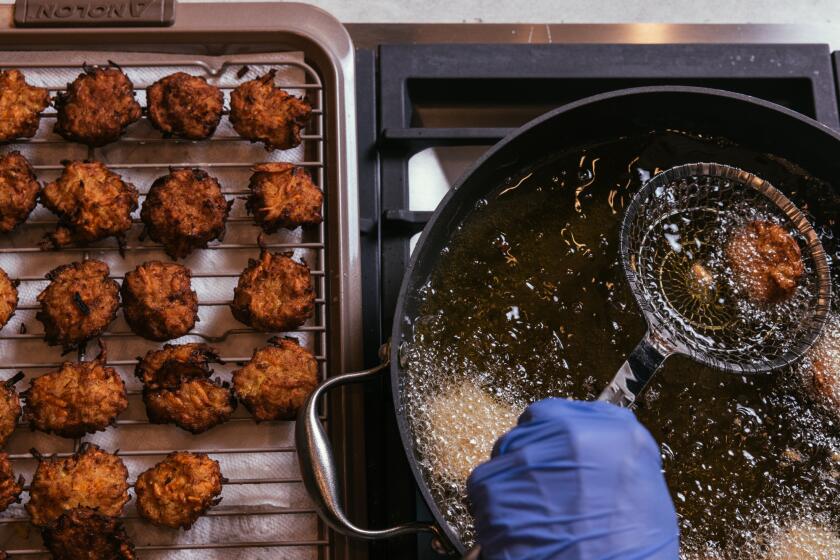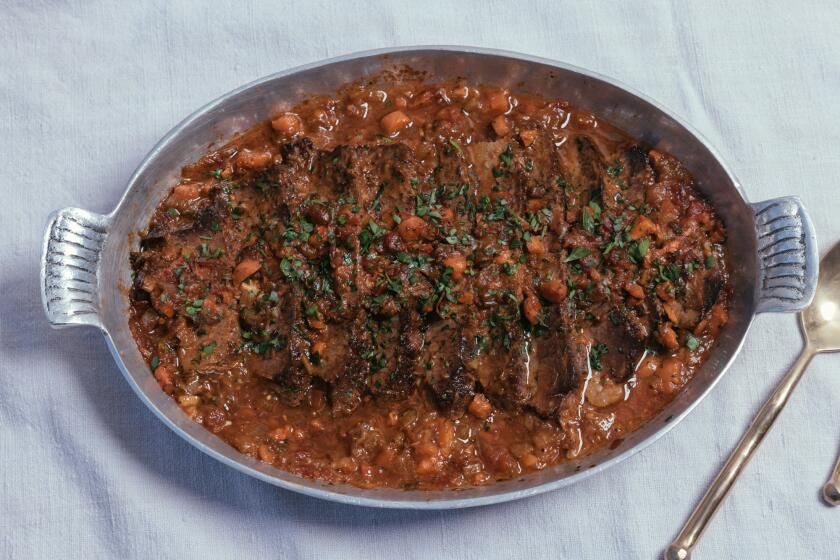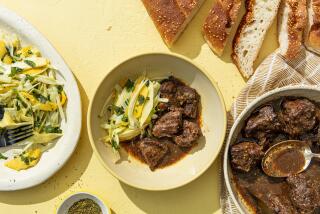Make the best brisket, every time
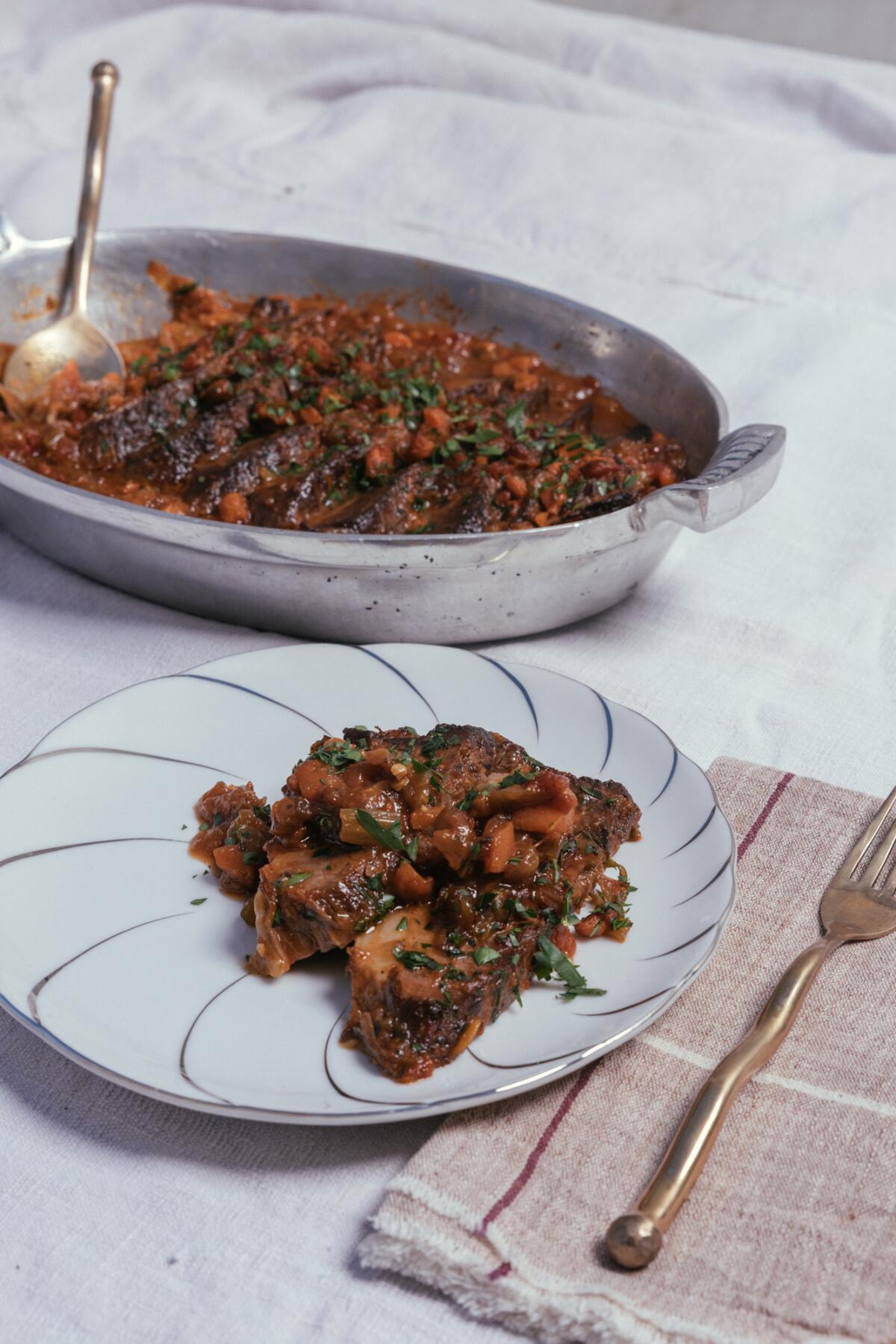
- Share via
Hanukkah, a.k.a. major brisket season, is here. A classic Jewish holiday food, brisket is a cinch to prepare and a great accompaniment to latkes, which require much more hands-on attention. One large brisket can feed many and last for several meals (it’s better the next day and improves every day thereafter), easing the cooking pressure for the eight nights of candle lighting.
I must admit, as a child and well into adulthood, I hated brisket. Granted, my experience with it was limited to what my mother made (fortunately, very infrequently); it was always stringy, tough and not particularly flavorful. Because she was an otherwise excellent cook (and a caterer), I assumed that what she served was how it was supposed to be.
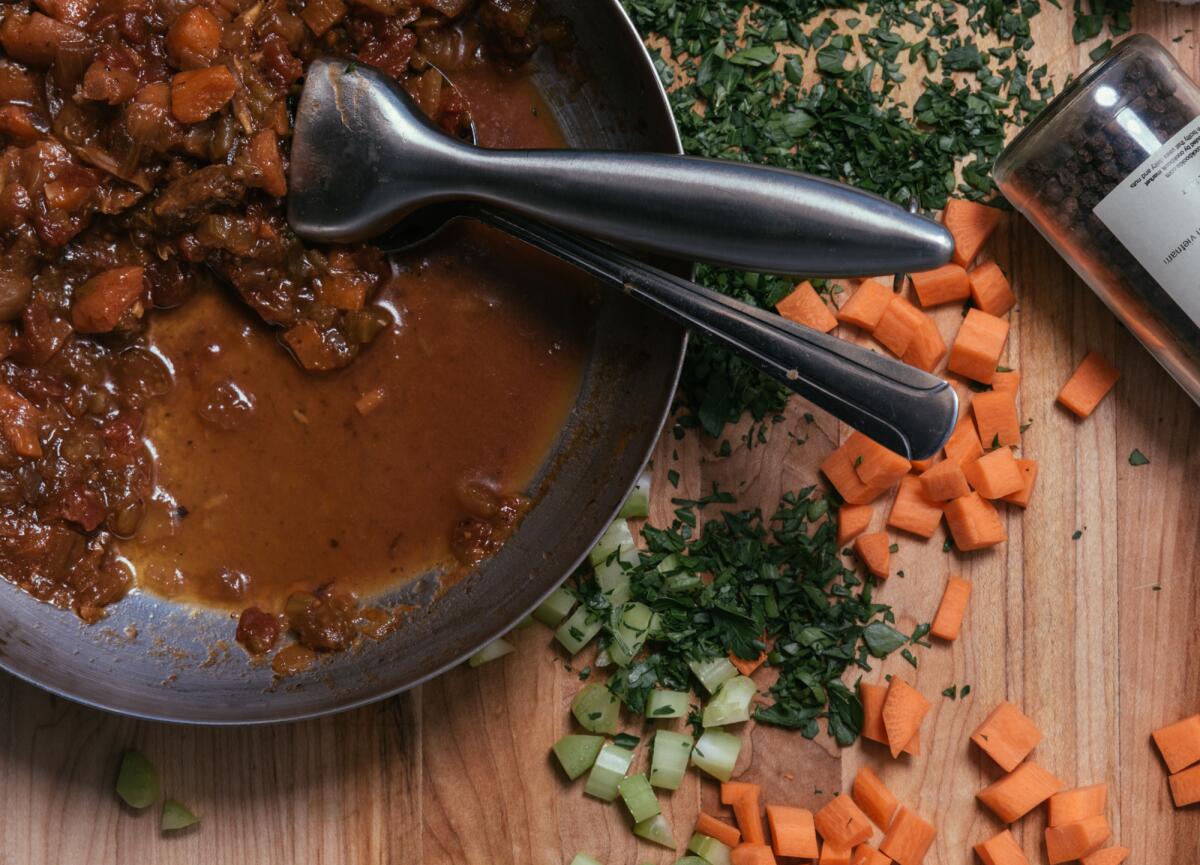
For years, I kept my disdain for brisket to myself for fear of committing Jewish culinary treason. Eventually, I needed to know what all the fuss was about — and to feed a crowd for the first Passover seder that I was hosting. So I pulled out some Jewish cookbooks and decided on Joan Nathan’s recipe for Moroccan-style brisket from her book “Jewish Cooking in America.” It called for ginger, saffron and olives, which appealed to me largely because it was so unlike what my mother served and also because I love olives. It was a hit and delicious in a way that I had no idea brisket could be. Having discovered “good” brisket, I began exploring other recipes.
This latkes recipe produces crisp, golden potato cakes with squash served with a Middle Eastern-inspired yogurt-mint dip with date molasses. Serve for Hanukkah.
There were the decidedly no-fuss recipes that dump one or more processed ingredients such as ketchup, onion soup mix and Coca-Cola (though not necessarily all together) on the meat before shoving it in the oven for 3 hours. And there were more complex ones that called for searing the meat and sautéing fresh, aromatic vegetables like onions, carrots and celery before adding tomatoes, balsamic, red wine or apple cider vinegar and honey or molasses to the pan before cooking it. Sweet or savory, simple or sophisticated, three hours was the magic cook time that almost every recipe specified.
Over the years, I have ditched the saffron and olives from my first brisket and taken a decidedly hamish approach to ingredients, sticking with the basics.
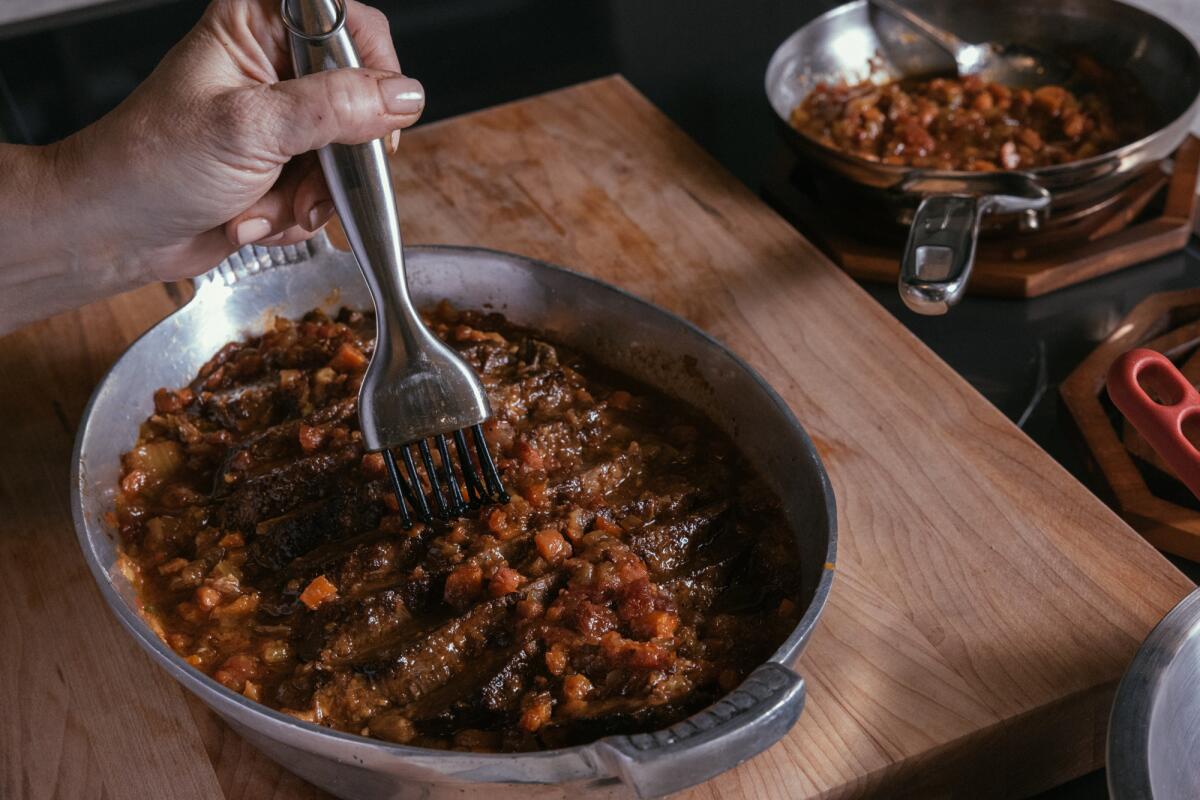
The method, however, is sound and includes several best practices that I still adhere to today. I use it as a starting point. Sometimes I make it as is. Sometimes I embellish it depending on my mood, the occasion and the crowd. However I may modify the ingredients, I have found that investing a few minutes to sear the meat and saute the aromatics makes a huge difference in the final product. A few other best practices also make a significant difference such that even with only very basic ingredients, the brisket is always the best it can be — and intensely delicious.
Seven keys to the best brisket ever
- Know your meat. Brisket is the chest muscle of the cow. It is full of tough connective tissue and needs to be cooked for a long time at a low heat to tenderize it. A whole brisket has two parts, the front section, also called the point, which is thicker and more marbled, often with large chunks of fat; and, the back section, also called the flat, which is leaner and often more flavorful. In general, if you plan to slice your brisket, the flat will hold its shape better. If you plan to shred it, go with the point.
Know your flavorings. Season all of the surfaces generously — about a tablespoon of salt per 5 pounds of meat. If possible, salt it the day before you want to cook it and let it sit overnight in the refrigerator. The salt will fully penetrate the meat, making it more juicy and flavorful. Seasoning immediately before searing is OK too.
Aromatics such as onions, celery and carrots will enhance the aroma surrounding the meat as well as infuse it with flavor. Sautéing them so that they will caramelize and release their aromas will add more flavor. Leave them in larger chunks so that they don’t dissolve into the sauce.
Acid in the sauce such as tomatoes, tomato sauce, wine, vinegar and citrus juice will help to tenderize the proteins and to brighten the overall flavor of the dish.
Finally, keep it simple. Yes, you can add all sorts of ingredients-of-the-moment such as fish sauce, powdered mushrooms, miso or pomegranate molasses, but you don’t need them to make a fabulous brisket.
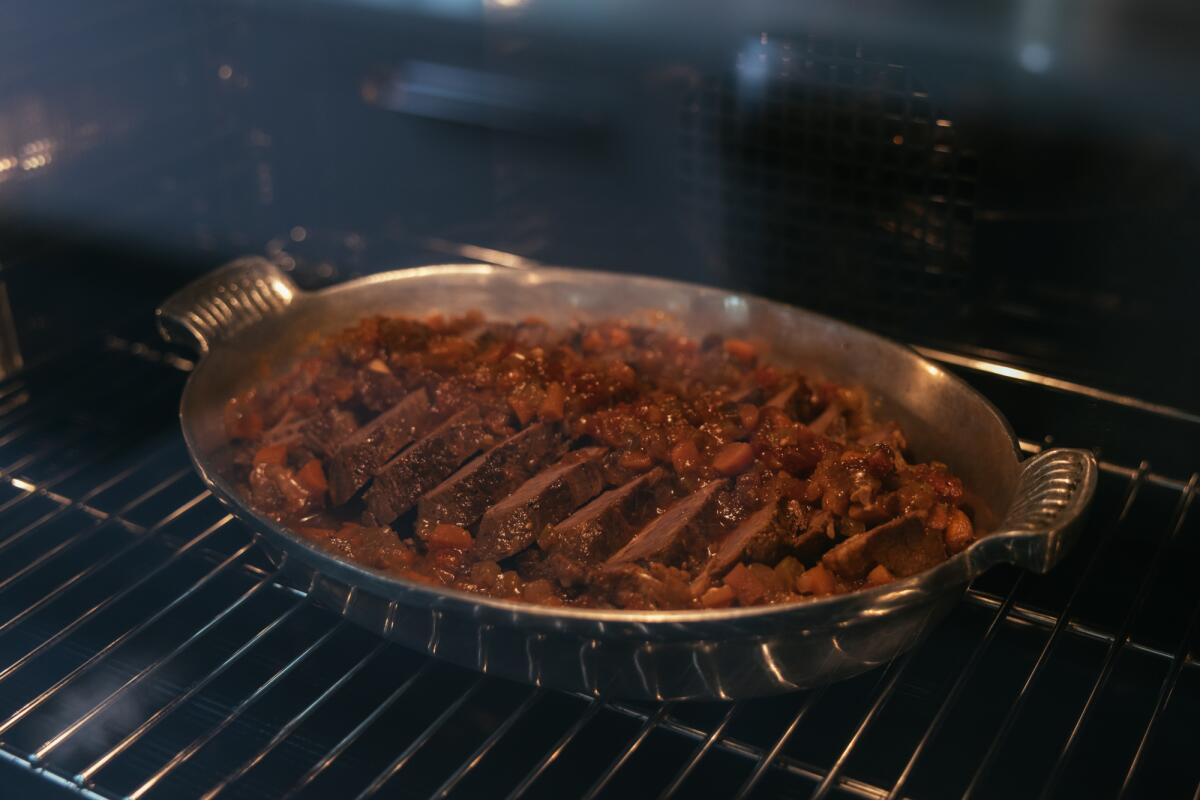 (Dania Maxwell / Los Angeles Times)
(Dania Maxwell / Los Angeles Times)Use your oven. The best way to transform a hunk of tough muscle into something tender and succulent is to braise it — that is, cook it at low heat for a long time (in a covered pan) in enough liquid to cover only about ⅔ of the roast. A few preliminary steps prior to sliding the pan into the oven will make your brisket the best it can be.
First, sear the meat in a hot pan over medium-high heat for a few minutes on each side until it is beautifully browned. A tip on searing: Score the fat cap and sear that side first so that it will render nicely while searing.
Next, saute the aromatics. Here too, the caramelization brings out more flavor. Then add your liquid and other flavorings to the pan and bring it all to a boil. Cover the pan and slide into a preheated oven.
Cook it in the oven rather than on the stovetop. The oven provides a constant temperature around the pot, which allows the contents to cook evenly.
- Give it time. Buy the brisket at least a day before you plan to cook it so that you can season it and let it rest overnight. Cook the brisket the day — or up to 4 days before — you plan to serve it. Chill it for a good 8 to 12 hours in its juices, which will help the meat retain its moisture and give the flavors a chance to marry. Once cold, you can easily skim the fat from the surface.
- Cut it properly. It is easier to cut even, ½-inch thick slices while the meat is cold and firm. Cut against the grain to prevent shredding. To identify the direction of the grain, turn the brisket upside down and look for the long muscle striations. Slice perpendicular to the direction of the striations.
- Reheat gently. Once the meat is sliced, lay it out in an ovenproof serving dish along with the gravy. Cover and heat in a low to moderate oven — no more than 350 degrees — for 30 to 60 minutes. As with the cooking, reheating low and slow will keep the meat tender and moist.
- Remember the gravy. If you have too much liquid left in the pan, boil it rapidly (separate from the meat) to reduce and thicken it. If you prefer a thicker gravy, puree the aromatics with the jus. If it needs more sauce, add some liquid such as water, broth or tomato sauce and a bit of acid — a few tablespoons of citrus or vinegar — to the pan when reheating.
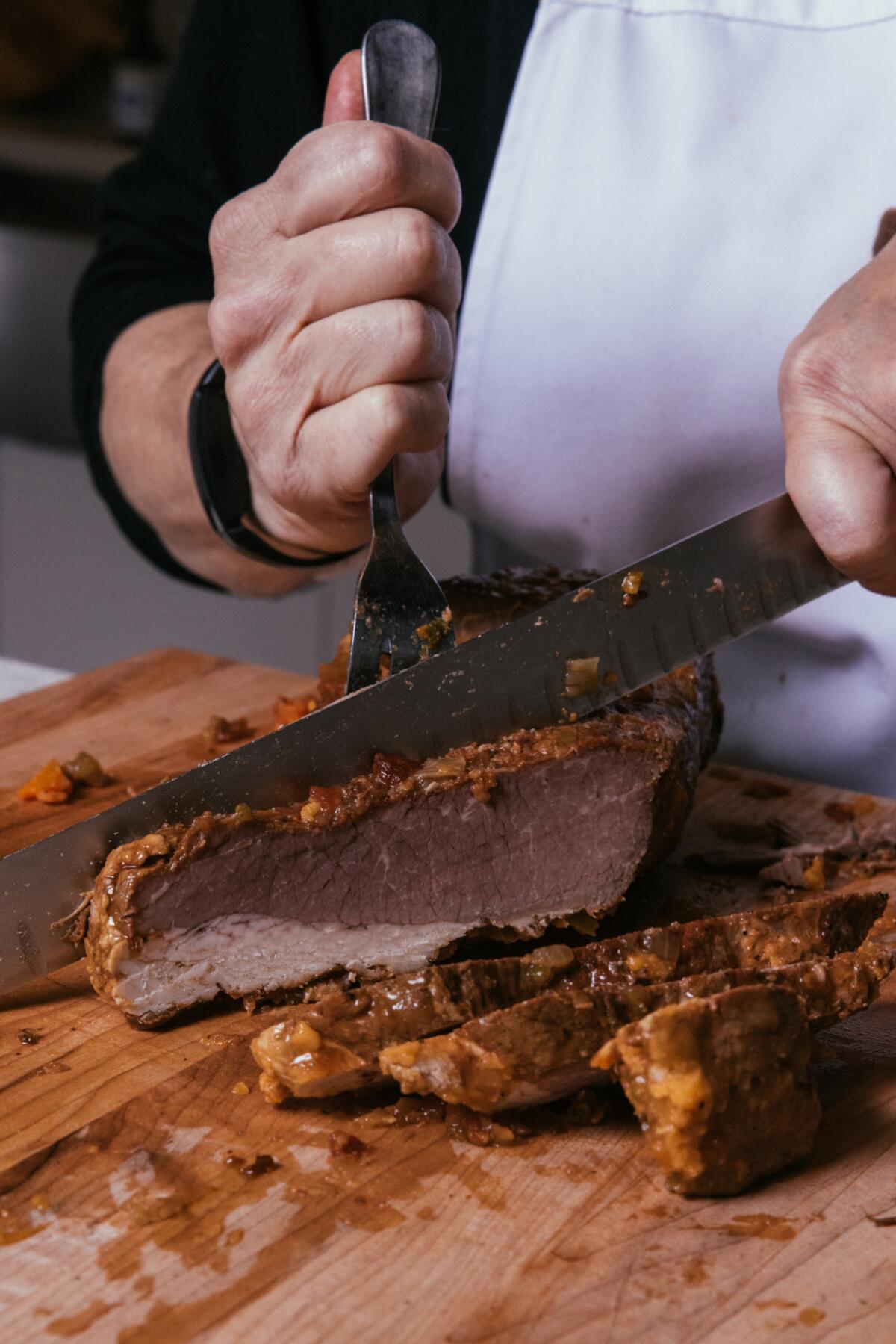
I recently inherited my mother’s long-retired recipe files, and, curious, I dug up her brisket recipe. It was immediately clear why her brisket was so awful. Aside from the meat, it called for salt, pepper, paprika, Accent and half a package of onion soup mix. Quantities are not specified. The method has you pile everything onto the brisket, wrap it in foil and roast for (the magical) 3 hours. I could go on but the horse is already way dead. How I wish she had known to use even a few of these best practices.
Best Brisket Ever
More to Read
Eat your way across L.A.
Get our weekly Tasting Notes newsletter for reviews, news and more.
You may occasionally receive promotional content from the Los Angeles Times.
